Quality of the Environment in Japan 1995
Section10. The Influence on the Environment of the Hanshia-Awaji Great Earthquake
1. Damage due to the Earthquake
A strong earthquake occurred on 17 January 1995 centered on the southern part of Hyogo Prefecture and, in addition to causing the most terrible human suffering since the World War II, exerted an immeasur-able influence on daily life, such as by the destruction of houses, the collapsing of highways and the cutting of the so-called lifelines of electricity and water. Further, anxiety was caused about a secondary disaster due to water pollution and air pollution caused by hazardous substances that accompanied the damage due to the earthquake.
In every area affected by the damage, accompanying the collapse of buildings, an enormous amount of rubble and waste exceeding 18 million tons was produced. Because the capacity of the local governments for collecting and removing rubble and waste and collapsed houses was exceeded, in the affected areas rubble and waste were temporarily burnt in the open air, and in February complaints from residents about sore throats and eyes due to smoke were reported. The national Hanshin-Awaji Rehabilitation Committee has positioned the removal of rubble and dealing with collapsed houses as the fundamental operations for rehabilitation. Proposals were made in February, concerning promotion of cooperation among municipalities, the prefecture and the nation, the recycling of the iron, aluminum, concrete, etc. that is removed, and systematic and block by block removal in order to promote the various rehabilitation projects, and rubble management plans that incorporated these proposals were decided on by Hyogo Prefecture and the other municipalities concerned (Figure 5-10-1).
In factories and businesses, along with the damage to pollution prevention facilities due to the earthquake, the spill of ammonia and hydrochloric acid and the falling from the port of drums containing the raw materials of synthetic resins were reported. Further, the leakage of hazardous substances caused concern, but as of March 1995 damage has not been confirmed.
At places where buildings and apartment buildings collapsed and broke apart the scattering of asbestos has caused concern. Asbestos is a mineral that has crystallized in a fibrous form and because it has excellent electrical insulation and heat insulation properties it is used in heat insulation material and automobile parts, etc. But because there is concern that asbestos that has become dust and has floated in the air affects the health, such as causing cancer by being inhaled, in the Air Pollution Control Law and in other laws, restrictions on discharges from factories, removal work by experts and strict management after removal are stipulated. In the area affected by the disaster the work of dismantling and removing buildings for the purpose of restoration is going on and in order to prevent the scattering of asbestos that accompanies this, asbestos scattering prevention countermeasures are settled in the liaison committee on asbestos countermeasures of the national govemment and the related ministries and agencies are striving for thorough cooperation with the related local governments.
Further, since it can be expected that many of the very tiny particles of sand that were blown up from underground because of the ground liquefaction phenomenon due to the earthquake, and that much of the dust of concrete that accompanies the dismantling work will float in the air, guidance is being given to carry out countermeasures includ ing spraying water.
Fig. 5-10-1 Flow of Treatment and Disposal of Waste Generated by Disaster
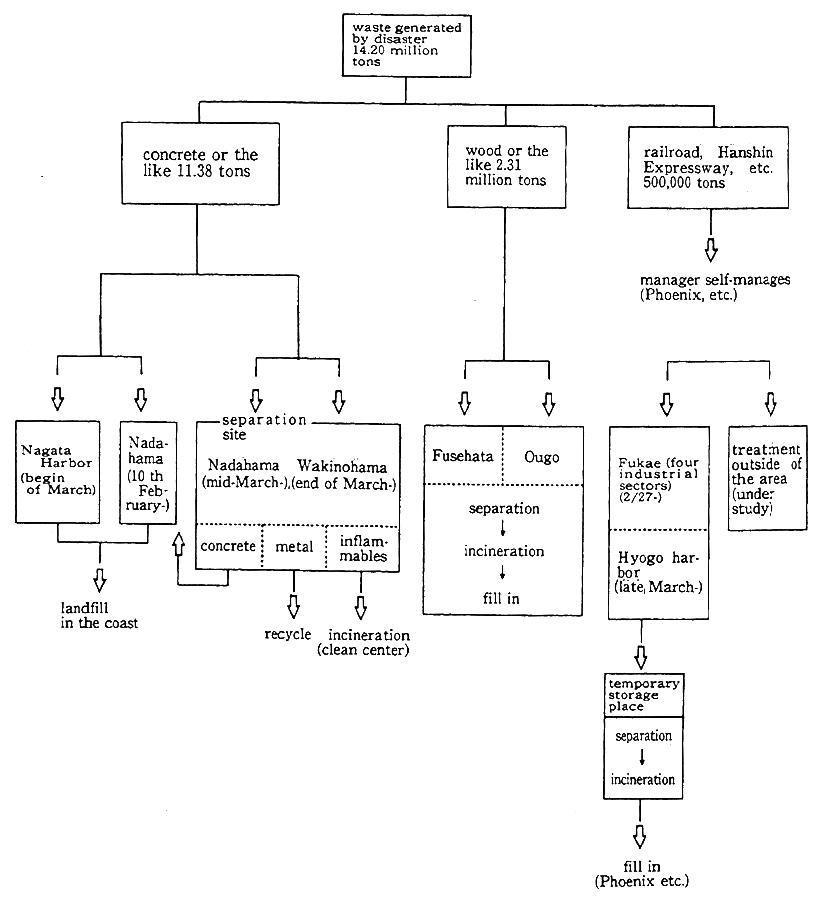
Source: Kobe city As of 31 March 1995 (estimate)
Further, because there is concern about the release into the air of the remaining specified CFCs from the machines that use specified CFCS inside the collapsed buildings, the local governments and busines ses are cooperating as much as possible to recover the substances.
In one part of the sewage treatment plant of Kobe City the sewage treatment facilities suffered great damage from the earthquake and advanced treatment of sewage became impossible and it was a hindrance to sewage treatment. For this reason sewage that wasn't sufficiently treated flowed into the ocean as it was and because there was concern about marine pollution, particularly, an outbreak of red tide in summertime, in February a temporary settling pond was in-stalled in a canal and measures to cope with the situation were carried out, such as discharging after settling and disinfection.
Of the areas that suffered from the disaster, in Kobe City and Amagasaki City, etc. there are former category one regions under the Law Concerning Compensation and Prevention of Pollution-Related Health Damage. Besides carrying out measures aiming to protect patients certified under this law so that they will be able to receive treatment as usual even if the pollution disease treatment notebook is lost, setting up places to handle consulting with certified patients that suffered from the disaster, revising the law and establishing special measures to help patients that could not request renewal of recognition within the time period due to the disaster, confirming the location of certified patients and going around to consult with the patients was begun in March, by the health nurses. Further, the Pollution-Related Health Damage Compensation and Prevention Association, from the viewpoint of contributing to the prevention of bronchial asthma and helping to prevent colds and dust, sent about 300,000 masks to the disaster area as part of an operation to prevent health damage.
2. Emergency Monitoring
Based on the situation caused by worsening of the environment in the disaster area, the Environment Agency conducted monitoring of the water and air quality twice in February and March 1995 from the viewpoint of preventing secondary pollution.
The air quality monitoring in February was carried out targeting 20 items, such as asbestos, chlorine and organochlorine compounds at 50 points in 13 municipalities including Kobe City, Amagasaki City and Hokudan Town. According to the results of this survey, concerning asbestos, the measured environmental concentrations settled into the range of the fluctuations in environmental concentrations measured in Japan's urban areas, but there were also some values that were a little higher than generally observed values and in the areas of the work of dismantling and removing buildings, where measures were not taken to prevent scattering into the air, high concentrations were detected (Table 5-10-1). Further, concerning substances other than asbestos, the measured environmental concentrations were generally in the range of the fluctuations of the environmental concentrations of the urban areas of Japan and, at present, secondary pollution that would immediately become a problem because of its effect on health, due to the leakage of hazardous substances, did not occur (Table 5-10-2).
Table 5-10-1 Emergency Monitoring Survey
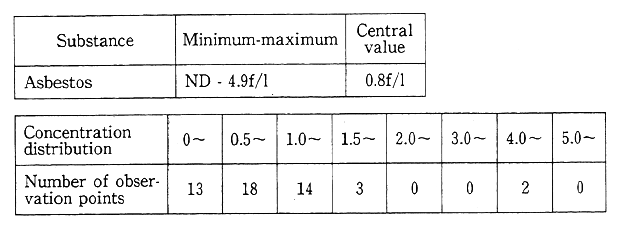
Source: Environment Agency
In the February water quality monitoring on 23 health items and six living environment items, such as BOD and pH were targeted at 29 points in wells and 37 points in the sea and rivers of the four cities of Kobe, Amagasaki, Nishinomiya and Ashiya, but conspicuous water pollution due to the leakage of hazardous substances was not
3. Dealing with the Situation from Now on
The area damaged by the Hanshin-Awaji Great Earthquake has been a region with conspicuous pollution for a long time, and it is also a region in which various pollution countermeasures for this situation have come to be enthusiastically promoted. In the earthquake this time, in part of the region it was reported that parks that had been established as part of the countermeasures for the purpose of environmental conser vation prevented the spread of fire. From now on, as for good town planning from the perspective of the environment, town planning that is able to withstand disasters and that is easy on the environment is called for while promoting environmental considerations in the rehabilitation process with the awareness that there are many aspects in common between town planning that is able to withstand disasters and the provision of green areas and parks, the improvement of mixed residential and industrial areas and low-rise densely built-up urban areas.
Table 5-10-2 Emergency Monitoring Survey
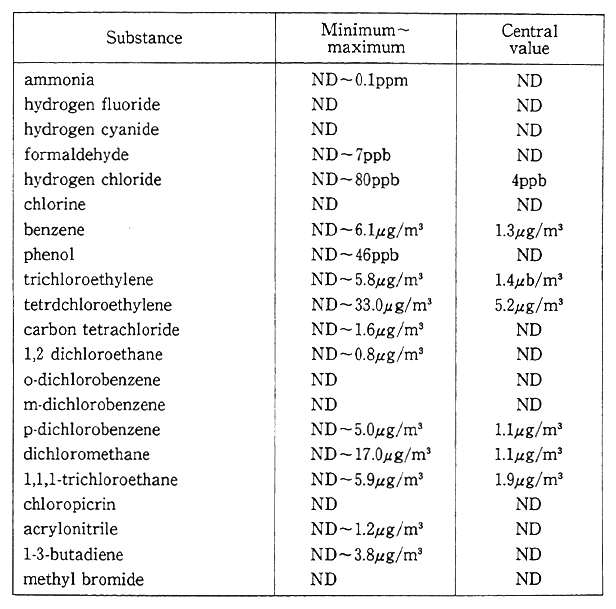
Source: Environment Agency
Final Remarks
For people who were born into the current civilization, because they are in it at just present, it is difficult for them to examine and become aware, objectively, of the characteristics this civilization possesses and what their consequences are.
The workings of life on the earth have a time scale that far exceeds the history of humanity, compared to it the history of humanity is something only recent. However, if viewed from the life of a single person in this enormous amount of time, the present civilization and humanity's history have come to be inherited while many civilizations up to now have repeatedly been appearing, prospering and declining. Nevertheless, while the North-South problem has been in background, during a few centuries from the modern age until the present time human population has grown enormously and human society has accornpushed economic development and for the first time in history has come to share the common awareness that global environment and resources are limited. In this way people are forced to ask themselves again the way human society should be.
It is true that in history up to now many civilizations and species of life have risen and fallen and when the current civilization, which has arrived by passing through agricultural civilization and industrial civilization at the type of socioeconomic activity and lifestyle, with mass production, mass consumption and mass disposal, is considered, it might not be at all easy to change the civilization of today sustainable. Nevertheless, people have the responsibility to make serious efforts so that the future generations and their civilization will not face to the serious situation of being affected by such problems as global warming.
From this understanding, in the present report the relationship between the environment and civilization was taken up and, while looking back from the environmental point of view on human evolution and ancient civilizations and probing the problems and historical implications of the present civilization, an attempt was made to collectively consider the way the society should be from now on.
As seen in Chapter 1, humanity was born on the earth as one living species in the global ecological system, but when the present activity of human beings is evaluated with respect to its relationship to the environment, it has come to be understood that it has become a being with characteristics that are different from other organisms. On the one hand, from a consideration of ancient civilizations it is able to be learned that civilizations and the environment have come to have a deep relationship. For example, it is able to be seen that civilizations exist dependent upon the environment such as climate and forests, and at the same time, civilizations have come to impose various burdens on the environment. And certain civilizations, through the workings of human beings, have damaged the environment over certain limits that is the foundation of life, and this became one of the causes of their decline.
Consequently, it can be said that the natural world is skillfully equipped with a mechanism to maintain homeostasis within it. A mechanism in the system that maintains life which, when anything disadvantageous occurs, automatically sets into motion a counter action to remediate it to maintain the balance of the whole. This mechanism of the natural world that was first detected in the human body is known as homeostasis.
And now turning to the present civilization, by means of mea-sures, such as saving energy and resources, a certain success has been achieved, but it is difficult to say that a socioeconomic mechanism that restricts by itself the increase of the load on the environment has been sufficiently incorporated up to now. In fact, the various burdens on the environment due to the activity of human society have been increasing on a global scale since the dawn of history. Particularly during the perind from the modern age up to the present day, while expanding the area of that activity throughout the world and further increasing its speed, people have finally reached the point of having brought about the danger of exerting an irreversible influence on the indivisible global environment that is the foundation of the existence of humanity.
Figuratively speaking, it can be said that in the present civilization humanity has continued to play a game without a sufficient understanding of the basic rules of development and existence that are the agreement in the natural world and has been playing a game without following the basic rules. Consequently, the global environment which is the foundation for the continued existence of humanity is damaged and the danger of impediment to the continuance of the game is arising.
If that is the case, what is the nature of the points at which the present civilization has not followed the rules of the natural world ? These can be roughly summarized into the following two points.
The first point is nonobservance of the fact that the things received from the natural world must be returned to the natural world in a form that is easy to be received, and further, within a range that the natural world can receive. That is to say, that the human beings have expanded activities that hinder the circulation of the natural world. In other word, people has discharged substances that are not able to circulate easily in the natural world or in an amount that the circulation is impossible resulted in staying in the environment
The second point is that symbiosis with nature has not been properly realized. Humanity is one species of life in nature and there are still many in the mechanism of nature that humanity doesn't know. Humanity has been recently expanding its share in the nature explosively and in the process has caused the extinction of many species of life.
When the factors that have caused this problem are looked at from an economic perspective it can be mentioned that awareness concerning the costs to society produced along with the load on the environment due to human activity were not clear, and because appropriate environmental measures have not sufficiently carried out, activity has been continuing as it was without these costs being appropriately incorporated into the market mechanism.
These problems can be regarded as having brought about today's actual situation in which the global environment that is the foundation of human's own existence is in danger of being damaged due to the activity of human society itself as a result of promoting improper use of the environment.
Generally, even if it looks as if a great benefit has been temporarily obtained by actions that do not go along with the rules, they are definitely not beneficial acts in the long run. The present civilization also is, indeed, the same. For this reason from now on it is necessary to revise activities that do not go along with the rules.
It is true that doing so is not easy. This is because the present civilization has come to construct its economic and social systems premised on activities that do not follow the rules of nature mentioned above and revising them involves individual interests, further, there is an intimate relation with the issues of business fluctuations and economic growth. Thus, the construction of a new socioeconomic mechanism will be painful. That is, even if an individual wants to bear the environmental costs and one strives to live together with other organisms paying attention to sound material cycle, extensive efforts are necessary to make the social and economic mechanisms which respond to these attempts compatible with them.
Japan enacted the Basic Environment Law in 1993 and in 1994, decided on the Basic Environment Plan based on the law. This set forth, domestically and internationally, the intention of changing the Japanese society to sustainable one that would impose less burden on the environment, and it is the point of departure for the construction of an economic and social system that followed the basic rules of the natural world.
In the Environment Basic Plan "building a socioeconomic system fostering an environmentally sound material cycle," "harmonious co-existence between nature and humankind," "participation by all sectors of society sharing fair burdens" and "promoting international activities" have been set as four long-term objectives. Further, various measures should be implemented according to the basic concept of taking respon-sible action, such as the polluter pays the implementing cost of various measures for environmental conservation in line with the Polluter-Pays-Principle advocated by OECD, etc., which requires that the cost of environmental use must be reflected in the price of goods and services, to realize these objectives. From now on, the formation of a new socioeconomic mechanism for a sustainable society by means of devel-oping and putting into practice individual specific measures under this basic concept is called for.
Particularly, Japan, which has accomplished rapid economic development while strengthening ties to the world and now, from the perspective of load on the global environment and from the economic perspective, has reached a point of having great influence in interna-tional society, is called upon to positively contribute to the world to support the self-help efforts of developing countries towards the com-patibility of the environment and development based on accumulated experiences and technologes gained in struggling against environmental pollution up to now, and, of course, to take the initiative itself in creating a sustainable economic society. Among these also as seen in Chapter 2, concerning the creation of sustainable societies in the Asia-Pacific region that is expected to continue to have rapid growth andserious environmental problems, the role that Japan should fulfill will increase still more in the future. Further, as seen in Chapter 3, properly recognition of the condition of nearby environment is also essential.
At present already many people, not just national and and local governments, but also corporations and private non-profit organiza-tions, are engaged in various environmental activities that follow the basic concepts set out in the Basic Environment Plan. Chapter 4 of the present report appeals the importance of having the viewpoint that the effect will be increased still more when all sectors of society are promoting these kinds of environmental measures. This is because, considering the change in the character of environmental problems today, including global warming, increasing the effect of the measures as much as possible and constructing as quickly as possible the mechanism of an sustainable society within the limits of time, manpower and budget from now on have been called for. A method to quantitatively evaluate these effects has not yet been established and is a task for the future. It is necessary to be sufficiently aware that there are many among the costs and effects related to the environment that an evaluation in terms of money is not suitable.
As for the long-term objectives set forth in the Basic Environment Plan, they may probably be said to set forth the path of sustainable development for humanity by following the basic rules of the natural world, so to speak. Of course the questions were how the environment and the economy could be skillfully integrated, how the difference in wealth between the developed and developing countries could be narrowed and how a sustainable society should be shaped and it cannot be said that their complete image is clearly seen. However, as can be also seen in last year's report, early environmental investment, in addition to environmental conservation, supports the long-term health of the economy, there is a possibility of realizing the compatibility of economy and environment in the next century and, further, internationally,earnest efforts have been continued concerning such concrete policies as changes in lifestyle and the promotion of technological development. Moreover, efforts are also being made to accumulate still more scientific knowledge.
If each individual is able to seriously realize the importance of the environment and if humanity is able to exhibit its wisdom and creativity directed towards creating a sustainable society and its system, there cannot but be the possibility of developing a society that is qualitatively different from the civilization up to now whose development has imposed many diverse load upon the environment, and of creating an affluent and beautiful global civilization.
The roles that all people living in the present age, including those who are in national and local governments and corporations and private non-profit organizations, should fulfill for the future of humanity are large and serious.
PartII
Chapter6. Comprehensive Promotion of Environmental Administration
Section1. Basic Environment Plan
1. Basic Environment Plan
As shown by urban and domestic pollution or by global warming, many current environmental problems are originated in daily activities of companies and individual citizens. And, environmental issues have become problems of global proportion in terms of scale and time affecting wide geographical areas and the lives of future generations.
To resolve these problems, it is essential that all sectors such as national and local governments, corporations, and the people share the fair burden and change current socioeconomic systems and life styles in order to establish a society that ensures sustainable development with less burden on the environment.
From this point of view, the Basic Environment Law, which specifies new ideas and various policies concerning preservation of the environment, was enacted in November 1993.
Under Article 15 of this law, the Basic Environment Plan lays down the government's fundamental principles of comprehensive longterm measures concerning conservation of the environment. The government's first Basic Environment Plan was decided upon by the Cabinet on 16 December 1994. This Plan sets the basic concepts and long-term objectives of environmental policy which are based on the Basic Environment Law, upon foreseeing through the mid-2lst century, and specifies the direction of environmental policies in the period toward the early 21st century. It thus aims to ensure that all groups and sectors of society share common understanding and cooperate with each other for conservation of the environment.
2. Details of the Plan's Formulation
On 14 January 1994, the Prime Minister consulted with the Central Environment Council (Chairman, Dr. Jiro Kondo) concerning how should be the Basic Environment Plan.
The Planning and Policy Committee of Central Environment Council (Chairman, Mr. Akio Morishima) conducted hearings with concerned ministries and agencies and organizations and deliberated on the matter (15 committee meetings and four sub-committee meetings). The Committee published the Interim Report on the Basic Environmental Plan on 5 July. It then conducted more hearings in nine blocks nationwide and invited opinions from the general public in writing as well. Six hundred and ten people responded with a total of 3,335 items. The Committee further deliberated on the matter (four committee meetings and three sub-committee meetings) taking the opinions gathered from the general public into consideration. On 9 December, a report was submitted to the Prime Minister by Chairman Kondo.
The Basic Environment Plan was decided upon by the Cabinet in conformity with this report on 16 December 1994.
3. Overview of the Basic Environment Plan
(1) Significance of the plan
This plan sets the long-term objectives of the Government's environmental policies foreseeing through the mid-2lst century. The plan systematically clarifies the Government's policies and the activities expected from local governments, corporations and people toward the beginning of the 21st century, and also specifies the roles of each sector and the measures to effectively promote the environmental policies.
(2) Four long-term objectives
The four long-term objectives of the environmental policies that this plan puts forth are "building a socioeconomic system fostering environmentally sound material cycle (referred ot as 'sound material cycle' hereafter)," "harmonious coexistence between nature and humankind (referred to as 'harmonious coexistence' hereafter)," "participation by all sectors of society sharing fair burden (referred to as 'participation' hereafter)," and "promoting international activities (referred to as 'international activities' hereafter)." The plan also declares that it is aiming to establish a "society which ensures sustainable development putting less load on the environment."
Comprehensive indicator (groups of indicators) to show the prog-ress of these long-term objectives are to be developed by the Govern-ment as early as possible and will be used for enforcement and in reviewing of the plan in the future.
(3) Future policy on environmental conservation
The plan lays down the basic measures for the enforcement of the policies and also prescribes every step to be taken to achieve the four long-term objectives described above. Combinations of diverse enforce-ment methods are to be used depending upon the nature of the problem to be dealt with. Enforcement of the policies is to be carried out comprehensively and systematically while maintaining the organic cooperation among the measures.
Objectives set for individual problems are to be reviewed when necessary in conformity with the Basic Environment Plan, or new objectives can be set if necessary to establish a plan for a particular problem.
Major steps to be taken to attain the objective "sound material cycle" are conserving the atmosphere, water environment, soil and ground environment; policies of waste and recycling; policies on envi-ronmental risks of chemicals ; environmental consideration in techno-logical development. Major steps to be taken to attain the goal of "objective harmonious coexistence" are coexistence compatible with the region's natural and social characteristics; conserving biodiver-sity; and securing and utilizing the blessings of a sound environment. To attain the objective "participation" the plan prescribes measures such as the role of each sector, promoting voluntary actions by each participant, and greening government operations. To achieve "measures forming the basis of environmental policy" the plan specifies, environ-mental impact assessments ; regulatory measures ; economic mea-sures ; environmental infrastructure improvement ; scientific research, monitoring, observation and development of environmental technol-ogy; providing and maintaining environmental information; regional environmental pollution control programs, environmental health; and settlement of pollution disputes. To attain the objectives of "interna-tional activities" the plan specifies promoting international cooperation for global environmental conservation, international cooperation in research, monitoring and observation of the environment; encouraging activities of local governments or private sectors; environmental con-siderations in international cooperation; measures based on interna-tional agreements concerning the conservation of the global environ-ment.
(4) Effective implementation of the plan
This plan is the nation's basic plan for environmental conserva-tion. It is therefore essential that between this plan and other national plans, harmony with this plan should be ensued relating to environmen-tal conservation.
Other national plans which are exclusively aiming at environrnen-tal conservation shall be formulated and promoted in accordance with the principal directions of this plan. As for other national plans which include provisions on environmental conservation, these are to be com-patible with the principal directions of this plan relating to environmen-tal conservation, so harmonious coordination shall be ensued with the plan.
The Government will have a deep understanding of the progress of the plan and will utilize this knowledge. The Central Environment Council will follow-up the progress of measures under the plan every year, hearing the opinions of the public and each sector of society. The review will be made in around five years after the cabinet decision of this plan.
4. Enforcement of the Basic Environment Plan
To effectively promote the Basic Environment Plan, the Council of Ministries and Agencies concerned on Promotion of the Basic Envi-ronment Plan has been set up. The council has started its work on the development of the comprehensive indicators to gauge the progress of the four long-term objectives set in the plan. The council has also commenced organizing the Government's overall activity plan concern-ing its leadership in tackling the conservation of the environment from the role of business owner as well as consumer.
Section2. Summary of Expenditure for Environmental Conservation
1. Outline of Budget and Fiscal Investment and Loan
The budget for environmental conservation for the fiscal year 1994 totals 1,905.4 billion yen, consisting of general and special accounts. This is an increase of 190.6 billion yen, 11.1%, as compared to the fiscal year of 1993, which had an initial budget of 1,714.8 billion yen. Out of this amount, 1,694.9 billion yen is allotted for pollution prevention related items, and 210.5 billion yen for the items related to conservation of the natural environment (Table 6-2.1). The amount of 2,909.2 billion yen has been allotted in the original budget plan for the environmental conservation works for those organizations to which the fiscal invest-ment and loan program of the fiscal year 1994 will be applied. This is an increase of 472.3 billion yen as compared with the fiscal year of 1993 in which the amount of 2,436.9 billion yen was initially budgeted (These figures do not include the amounts for projects that are not specified as environmental conservation works by those organizations to which the fiscal investment and loan program will be applied.).
2. Budget for Environmental Conservation
The budget for environmental conservation for the fiscal year 1994 is intended to promote various environmental conservation activ-ities such as the establishment of various standards; reinforcement of monitoring and control ; aid to private organizations engaged in works for pollution prevention ; promotion of public works for pollution pre-vention; promotion of research for pollution prevention; reinforce-ment of protective measures for pollution victims; promotion of mea-sures for the conservation of nature.
(1) Establishment of various quality standards
The amount of 1,566.3 million yen was appropriated in the budget to promote the establishment of environmental quality standards and emission standards which are fundamental in measures to control various pollutions such as air and water pollution.
(2) Reinforcement of monitoring and control
The amount of 7,397.41 million yen was appropriated in the budget to reinforce the monitoring and controlling of air pollution, water pollution, and so forth. Principal breakdown of the expenditure includes 828.85 million yen for facilities to monitor air and water pollution, 1,252.11 million yen for the measures to control chemical substances harmful to the environment, 645.31 million yen for measures to prevent water pollution, and 300.25 million yen for measures to prevent air pollution.
Table 6-2-1 Environment Conservation Budget Breakdown by Ministries and Agencies (Initial Amount)
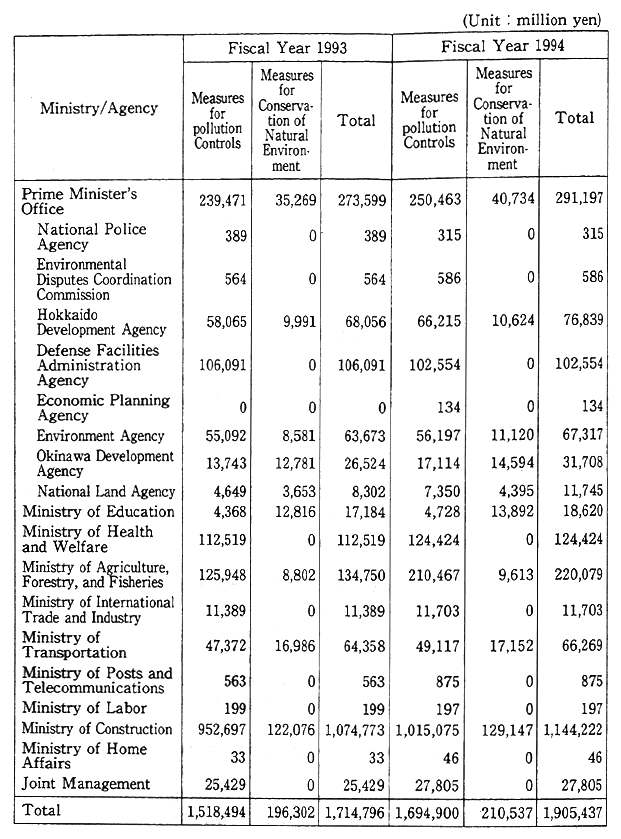
Notes: 1. Data by Environment Agency.
2. Excluding expenses allotted by implementation plans and the subsidy given at the time of redempfion, of NTT project.
3. Total amounts may not agree with actual amounts since figures below 1 million have been rounded.
(3) Aid to private organizations engaged in works for pollution prevention
The amount of 10,097.78 million yen was appropriated to promote the establishment of facilities for pollution prevention for private businesses. Principal breakdown includes 4,230.57 million yen for the expenses related to construction transfer ventures of the Japan Environ-ment Corporation, and 1,280.23 million yen for measures to preserve the environment of fishing grounds.
(4) Promotion of public works for pollution prevention
A total of 1,584,411.52 million yen was appropriated for the promotion of public works for pollution prevention. Principal break-down includes 1,050,448 million yen for sewerage works, 136,223.52 million yen for noise prevention measures for schools and residences near public airports or defense facilities, 139,961.6 million yen for the improvement of waste management facilities, 184,145.72 million yen for drainage works for farming communities, 13,515.48 million yen for measures for ground subsidence, 3,716 million yen for buffer green zones, and 3,974.23 million yen to subsidize construction for the preven-tion of pollution caused by suspended or abandoned mines.
(5) Promotion of research for pollution prevention
A total of 34,476.8 million yen was appropriated to promote research and study for the conservation of the environment. Principal breakdown includes 7,471.19 million yen for the necessary expenses for the national institutes of the Environment Agency, 1,918.04 million yen for research and experiment expenses related to the measures for pollution prevention at national institutions, 2,300 million yen for the promotion of comprehensive studies on the global environment, 1,468.35 million yen for the expenses of research for pollution prevention, 442.55 million yen for the research and development of alternative energy sources, and 876.2 million yen to subsidize scientific research.
(6) Reinforcement of protective measures for pollution victims
A total of 24,511.22 million yen was appropriated for the rein-forcement of protective measures for pollution victims. Principal break-down includes 22,915.05 million yen for the payment of compensation to pollution victims, 585.97 million yen for expenses related to mediation of disputes originating from pollution.
(7) Promotion of nature conservation measures
For the conservation of the natural environment, a total of 210,537.26 million yen was appropriated. Principal breakdown includes 10,034.45 million yen for the expenses to operate national and quasi-national parks, 140,960.02 million yen for the operating expenses of parks to promote afforestation in urban areas, 27,733.16 million yen in operating expenses for the improvement of coast and harbor environ-ments, and 12,115.87 million yen for the expenses necessary to procure historic sites.
(8) Miscellaneous
A total of 32,438.82 million yen was appropriated for various miscellaneous works including 5,616.04 million yen to promote works related to carbon dioxide fixation and technology to allow its effective usage.
3. Fiscal Investment and Loan
With the recent tightened controls in conformity with environ-mental regulations, private businesses are required to invest in their own environmental facilities such as installing devices for pollution prevention and so on. To help them undergo these investments as smoothly as possible, financial aid is made available to them through various government-affiliated agencies such as the Japan Environment Corporation, Japan Development Bank, Hokkaido and Tohoku Develop-ment Corp., Environmental Hygiene Finance Corp., Smaller Business Finance Corp., People's Finance Corp., Small Business Promotion Corp., Agriculture, Forestry and Fishery Finance Corp., Metal and Mining Industries Corp. of Japan, and the Okinawa Development Finance Corp.
Financial aid is also made available through local government bond programs to help promote local public entities' works such as improvement of sewerage system and waste treatment facilities.
4. Financial Aid by Way of Tax System for Environmental Conservation
(1) Aid provided by the Japan Environment Corporation
1) Operations of the Japan Environment Corporation
The Japan Environment Corporation was first established as the Pollution Control Service Corporation in October 1965 in accordance with the Pollution Control Service Corporation Law. Its major objective was to resolve industrial pollution problems such as air and water pollution, which were becoming a serious problem as a result of the Japan's high economic growth in late 1950's. Ever since, the Pollution Control Service Corp., an organization intended solely for promoting pollution preventive measures, has been actively providing aid to businesses who are taking measures to prevent pollution.
With the amendments to legislation in October 1992, details of its operations were reviewed to conform to the changes in the major themes of the Government's environmental administration policies. The organization's name was then changed to the Japan Environment Corporation and its operations were expanded from works for pollution prevention to environmental conservation including construction and transfer of facilities in the national and quasi-national parks areas.
In accordance with the amendments to legislation in May 1993, the organization established the Japan Fund for Global Environment to support activities of the preservation of the global environment conduct-ed by private organizations.
i. Construction and transfer program
The objects of the construction and transfer program are largely classified as follows: 1) group factory (factory complex) facilities; 2) buffer green belts; 3) green parks to abate air pollution; 4) industrial waste disposal facilities and green parks ; and 5) composite facilities at national and quasi-national parks. The Japan Environment Corporation is commissioned by a business entity who is to build a facility such as the above, complete the construction work and other operations as-sociated with the construction, and transfer the completed facility at the construction cost with long-term and low-interest payment terms.
ii. Loan program
Japan Environment Corporation is to provide loans for necessary expenses to individuals or businesses who are to install the facilities or to undertake the operation as described below: 1) industrial pollution control facilities; 2) industrial waste treatment facilities ; 3) urban soil and ground water pollution; and 4) combined sewage treatment tanks.
iii. Global environment, program
To cope with global environmental problems, the Japan Environ-ment Corporation provides 1) both domestic and overseas organizations with environmental information and technical know-how which can help preserve the environment of developing regions, and 2) financial aid and support using the Japan Fund for Global Environment toward activities of preserving the global environment carried out by private organiza-tions.
2) Operations of the fiscal year 1994
The business plan (the amount yielded from new contracts) for the fiscal year 1994 was 95 billion yen, which breaks down into 50 billion yen for construction and transfer program and 45 billion yen for loan program. To carry out the operations of the Japan Fund for Global Environment, one billion yen, which was invested by the Japan Environ-ment Corporation, and 0.8 billion yen, which was subsidized by the Japan Environment Corporation, were secured.
(2) Other financial loans provided by government-affiliated agencies
1) Loans provided by the Fund Financing System for Small Business Facility Modernization
The objective of the Fund Financing System for Small Business Facility Modernization is to promote modernization of facilities owned by small businesses in accordance with Law on Finance and Other Assistance for Small Business. Financial loans are made available for this purpose to small businesses through prefectural offices. As a part of this system, loans, are provided to specified pollution preventive facil-ities. Loans in the fiscal year 1994 were provided within the total financing limit of 48.6 billion yen. There is also a system with which small businesses can lease facilities from leasing organizations estab-lished in each prefecture. In the fiscal year 1994, the leasing operation turnover was within the total leasing limit of 66 billion yen.
2) Loans provided by the Smaller Business Finance Corp., People's Finance Corp., and the Okinawa Development Finance Corp.
In the fiscal year 1994, special loans for industrial pollution preventive facilities and for the transfer of factories owned by small businesses to solve the problem of overcrowding and to prevent pollu-tion were provided by the Smaller Business Finance Corp., People's Finance Corp., and the Okinawa Development Finance Corp.
3) Loans provided by the Small Business Promotion Corp.
The Small Business Promotion Corp.'s loan system in support of raising the standard of small businesses provides long-term and low-interest loans for small business owners who contribute to raising the standard of the small businesses structure. As a part of this system, loans were provided for operations to create industrial parks with those small factories that are moving out of residential areas into a site suitable for factories. Loans were provided also for operations of establishing public pollution preventive facilities which are conducted by small business associations.
4) Loans provided by the Japan Development Bank
In order to maintain and improve the environmental standard, loans were provided for pollution preventive facilities, waste manage-ment facilities, urban environment improvement operations, and opera-tions for the development of technology related to the environment.
5) Loans provided by the Hokkaido and Tohoku Development Corp.
In order to help maintain the environmental standard desired in the Hokkaido and Tohoku regions, loans were provided for the improvement of pollution preventive facilities.
6) Loans provided by the Agriculture, Forestry and Fishery Finance Corp.
To prevent environmental pollution caused by livestock opera-tions and to promote highly productive livestock operations at the same time, the Agriculture, Forestry and Fishery Finance Corp. provided a loan, as a fund to preserve the environment of animal farming commu-nities, for the expenses of establishing livestock excrement management facilities (The limit of loan for the fiscal year 1994 is 1.5 billion yen.).
7) Loans provided by the Metal and Mining Industries Corp. of Japan
In accordance with the Special Measures for Mine Damages Caused by the Metal Mining Industries, loans were provided for: the expenses necessary for the pollution preventive operations concerning abandoned mines (including expenses necessary for management of waste water from suspended or abandoned mines); contributions to the fund for preventive operations of pollution caused by mining; and business owners' defrayments per the Pollution Control Public Works Cost Allocation Law (The limit of loan for the fiscal year 1994 is 3.3 billion yen.).
(3) Measures in the tax system
1) National taxes
i. Since the Global Environment Fund was established within its organization, the Japan Environment Corporation has been added to a list of juridical persons who are exempted from inheritance taxes.
ii. The time period for the application of the special redemption act for waste recycling facilities (recycling facilities for plastic waste, wood waste, and construction waste) has been extended.
iii. Recycled paper manufacturing facilities qualify for Taxation System for Promoting Investments in the Energy Demand Structure Reform, and are continuously provided with reduced taxes, or applica-tion of the special redemption act.
iv. Facilities manufacturing hybrid energy regenerative automobiles, electric automobiles, automobiles using alternative energy sources other than petroleum and their fuel supply facilities have been added to the facilities qualifying for Taxation System for Promoting Investments in the Energy Demand Structure Reform. For those facilities reduced taxation or the special redemption act has been applied.
v. For those automobiles that meet the emission standards set for specific vehicles per the Law Concerning Special Measures for Total Emission Reduction of Nitrogen Oxides from Automobiles in Specified Areas, continuous reduced taxation or the special redemption act has been applied as they qualify for Taxation System for Promoting Invest-ments in the Energy Demand Structure Reform.
vi. Diesel fuel depth desulfurization apparatus have been added to the facilities qualifying for Taxation System for Promoting Investments in the Energy Demand Structure Reform, and reduced taxation or the special redemption act has been applied.
vii. The time period for the application of the special redemption act for pollution preventive facilities (specified dust treatment facilities, noise preventive facilities and industrial waste management facilities) has been extended.
viii. Upon necessary review concerning transfer of the ownership of a land obtained by a business cooperative association from the Japan Environment Corporation and resold to a member of the association, the time period of application of the reduced registration tax has been extended.
ix. The special redemption act has been established for the central facility which will be procured by a certain third sector organization according to the improvement plan in the areas developed per the Osaka Bay Area Development Law.
2) Local taxes
i. The time period for the application of reduced property tax to be applied to waste recycling facilities has been extended.
ii. Property taxes for properties within the controlled areas speci-fied in the Law for the Protection of Endangered Species of Wild Fauna and Flora have been reduced.
iii. Property tax has been reduced, and special land holding tax and business office tax have been exempted for the water treatment facil-ities in the source of city water facility specified in the Law to Take Measures for the Preservation of Water Quality in Headwaters Areas for the Purpose of Preventing Specific Trouble in Drinking Water Supply.
iv. The time period for the application of reduced auto tax and automobile acquisition tax for methanol vehicles and hybrid vehicles has been extended.
v. Types of vehicles to which the reduced automobile acquisition tax is applied when switching to vehicles that meet the emission stan-dards specified in the Law concerning Special Measures for Total Emission Reduction of Nitrogen Oxides from Automobiles in Specified Areas have been expanded.
vi. Reduced property tax for diesel fuel depth desulfurization appa-ratus has been established.
vii. The time period for the application of reduced property tax for pollution preventive facilities has been extended.
viii. The time period for the application of reduced real estate acquisi-tion tax for group factory (factory complex) facilities, which have been transferred from the Japan Environment Corporation, and tax exemp-tion of business office tax according to the amount of assets has been extended.
ix. Concerning certain central facilities to be improved in the areas specified in the Osaka Bay Area Development Law, exemption of the special land holding tax for the land to be used for those facilities, and exemption and reduction of business office tax for new and additional constructions according to the amount of assets have been enforced.
5. Expenses of Pollution Control Public Works Borne by Business
The Pollution Control Public Works Cost Allocation Law spec-ifies that the owner of the business by which the pollution was created is responsible for a part or whole expenses incurred by operations for pollution prevention depending upon the degree that the business activ-ities have contributed to creating the pollution. The projects for pollu-tion prevention include dredging, soil improvement due to contaminated farming soil, and the creation of buffer green zones which are carried out by the Government or local governments.
As of the end of 1994, the Japan Environment Corporation has reported that 105 projects for pollution prevention have been carried out in conformity with this law since it was executed in May 1971. The total expenses of the projects is approximately 276 billion yen and the total of the amount defrayed by business owners is approximately 129.6 billion yen, which is approximately 47.0% (Table 6-2-2).
Table 6-2-2 Application Status of the Pollution Control Public Works Cost Allocation Law
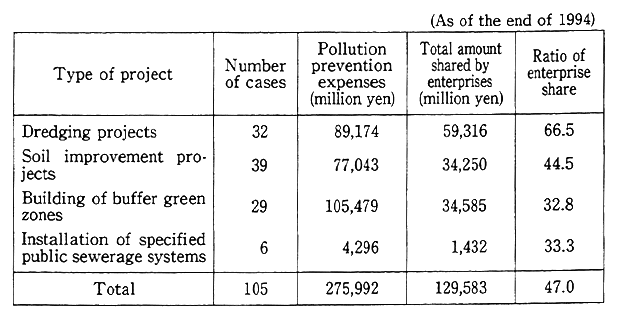
Notes:1. Data by Environment Agency.
2. Number of cases are calculated based on the numbers appearing in cost sharing plans. It does not agree with the actual number of projects since some are calculated by dividing a plan concerning one project.
3. Number of cases by project operator does not agree with the total number of cases since some of the project operators conduct both dredging arid building of buffer zones.
4. The pollution prevention expenses and the total amount shared by enter-prise are a total of amounts indicated in plans of those projects tlaat are still in progress, and of actual amounts of those projects that are already completed.
Section3. Promotion of Environmental Impact Assessment
1. Environmental Impact Assessment based on the Cabinet Decision
To prevent recurrence of tragic pollution or to keep destruction of the natural environment from advancing any further, it is critical that environmental contamination be prevented from occurring.
Environmental impact assessment is one of the effective means to prevent environmental destruction. When a project which could signifi-cantly affect the environment is being planned, environmental impact assessment is conducted to thoroughly investigate and estimate the possible impact to the environment. The results of the investigation is made public to the people in the area and their opinion is invited so that necessary measures can be taken to preserve the environment.
In Japan, ever since On the Environmental Conservation Mea-sures relating to Public Works" was approved by the Cabinet in June, 1972, environmental impact assessments have been conducted in con-formity with individual laws such as the Public Waters Reclamation Law, administrative guidance from ministries and agencies, and regula-tions and ordinances of local governments.
In August 1984, "On the Implementation of Environmental Impact Assessment" was decided upon by the Cabinet, and the "Implementation Scheme for Environmental Impact Assessment" was established as a unified rule concerning the Government's major project.
The outline specifies that the projects to which environmental impact assessment is to be applied should be of a large enough scale that they could possibly create a significant impact on the environment, and those projects should be carried out or licensed by the Government. The outline also specifies that those projects to be of a developmental nature such as construction of roads, dams, railways or airports, land reclama-tion from the sea or by drainage, and surface development projects such as land readjustments.
The following is the procedure that a business owner should follow to conduct an environmental impact assessment (Figure 6-3-1):
1) The owner of the business is to investigate, estimate, and assess the impact the project could create to the environment prior to the execution of the project and to prepare the environmental impact assessment preliminary documents in accordance with the guideline set by the agreement between the minister of the ministry having jurisdic-tion over the operation and the Director-General of the Environment Agency.
2) The business owner is to allow public inspection of the prelimi-nary documents and to hold an explanatory meeting.
3) The business owner is to make efforts to receive and understand opinions of the people residing in the area about the preliminary docu-ments. The business owner is to request the prefectureal governor in which the business is to operate for his opinion after receiving opinions from the heads of the municipalities concerned. and review the contents of the preliminary documents. The business owner is then to prepare an environmental impact statement and to make it open to public inspection.
4) The business owner is to take these opinions into considerations
Fig. 6-3-1 Procedures Specified in the Implementation Scheme for Environmental Impact Assessment
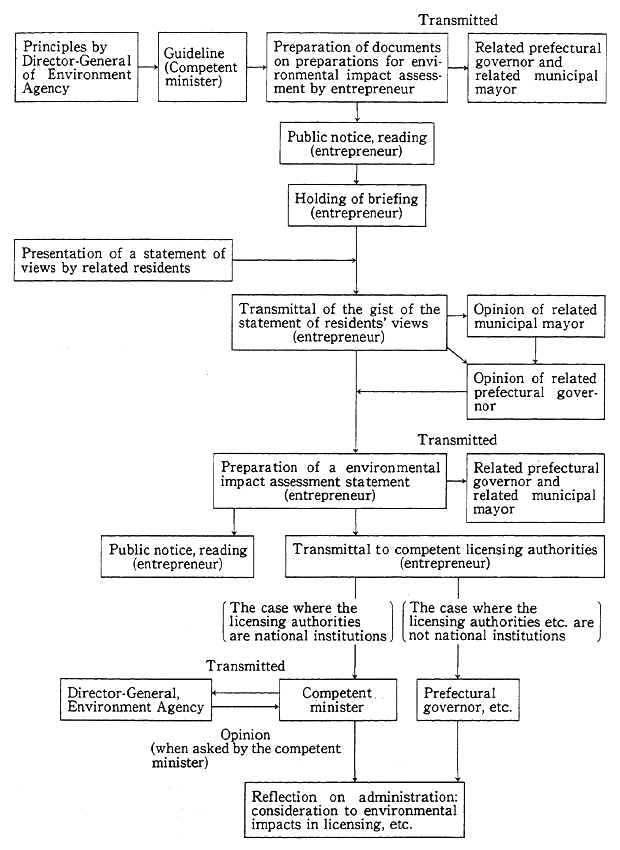
To reflect results from the environmental impact assessment in the Government's administration, the competent anthority is to take the results of the environmental impact assessment into consideration when issuing a license to the business in question. Also, the minister having jurisdiction over the business in question is to request the Director-General of the Environment Agency for his opinion about the environ-mental impact statement when necessary.
Execution of the environmental impact assessment according to this implementation scheme is to be initiated by administrative mea-sures taken by the ministry or agency having jurisdiction over the business, toward the business owner. As of the end of 1994, 37 projects have completed the environmental impact assessment (Table 6-3-1).
Table 6-3-1 Breakdown of Environmental Impact Assessment Con-ducted according to the Implementation Schenie of Environmental Impact Assessment

Notes: 1. Figures in parenthesis are the grand total as of the end of 1994.
2. For those projects that have implemented more than one environmental impact assessment for one project, each case of assessment is added in the type of project, but only one case is added to the total.
3. "Surface developrnenf" means developmental works on the surface such as land readjustment project, etc.
2. Environmental Impact Assessment by Individual Law
Environmental impact assessments have also been conducted in accordance with individual laws such as the Ports and Harbors Law and the Public Waters Reclamation Law. The followings are the major projects that were carried out in the fiscal year 1994.
(1) Ports and Harbors Program
The Ports and Harbors Program which has been established in accordance with the Ports and Harbors Law describes fundamental ideas of development, utilization, and maintenance of ports and harbors. An environmental impact assessment is to be conducted to judge the impact that this program could cause to the environment.
The Planning Committee of Ports and Harbors Council was summoned five times during the fiscal year 1994 and necessary adjust-ments were made in the plans for each harbor.
(2) Land reclamation in public waters
The Public Waters Reclamation Law specifies that the possible impact to the environment be studied prior to the issuance of license for land reclamation. Concerning land reclamation operations exceeding 50 ha or operations that require special considerations from the standpoint of environmental preservation, the minister having jurisdiction over the operation in question is to request the Director-General of the Environ-ment Agency for his opinion prior to the issuance of the license for reclamation. In the fiscal year 1994, a study was conducted on the land reclamation operation in Hakata Bay and necessary opinions were expressed by the Director-General.
(3) Location of power stations
The Ministry of International Trade and Industry conducts the environmental impact assessment for determination of location of power stations in accordance with the decision made by the ministry. At the time of examination and deliberation by the Electric Sources Development Council, the environmental preservation issue is also discussed based on the results from the environmental impact assess-ment conducted by the Ministry of International Trade and Industry.
In the fiscal year 1994, the Electric Sources Development Council met three times and necessary adjustments were made in the plans for the New Nagoya Power Station No. 7 and No. 8, and the Maizuru Power Station.
(4) Miscellaneous
1) City planning for urbanized regions
When city planning for urbanized regions is to be carried out in accordance with the City Planning Law, it is specified that the Director-General of the Environment Agency is to be requested for his opinion. In the fiscal year 1994, necessary measures were taken from the stand-point of the prevention of environmental pollution.
2) Improvement of comprehensive resort areas
When a basic concept is being formed or operations are being carried out to improve comprehensive resort areas in accordance with the Comprehensive Resort Areas Development Law, studies focusing on the preservation of the environment are to be conducted. The minister having jurisdiction over the operation in question is to consult the matter with the Director-General of Environment Agency prior to the approval of the basic concept of a project. In the fiscal year 1994, necessary adjustments were made to the project concept drawn by Ishikawa Prefecture.
Necessary adjustments were made focusing on the preservation of the environment for other projects with which the Environment Agency was consulted.
3. Research and Study on Environmental Impact Assess-ment
All concerned ministries and agencies are to promote the research and study of environmental impact assessment concerning the state of its enforcement both domestically and internationally. Upon studying the results of the research, necessary reviews are to be made and new legislation is to be created as necessary. In the fiscal year 1994, the Comprehensive Study Meeting on the Environmental Impact Assess-ment System was held and a full-scale study was started.
Concerning technical methods of environmental impact assess-ment, every effort has been made to improve accuracy. In the fiscal year 1994, all concerned ministries and agencies continued to promote research and develtpment on issues under their jurisdiction.
4. Measures Taken by Local Governments
Local governments are taking measures concerning environmen-tal impact assessment as well. As of the end of 1994, among all prefec-tures, and ordinance-designated cities, four local governments namely Hokkaido Prefecture, Tokyo Metropolis, Kanagawa Prefecture, and Kawasaki City enforced ordinances concerning environmental impact assessment, and 43 local governments implemented the implementation scheme of environmental impact assessment.
Section4. Promotion of Regional Environmental Conservation
1. Systematic and Comprehensive Promotion of Regional Environmental Conservation Measures
The attainment of sustainable development depends greatly on regional environmental conservation. Therefore, the role of local gov-ernments is crucial. Local governments are expected, according to the region's social and natural characteristics, to set up and present goals and courses of action. They should establish various systems, provide public facilities and promote voluntary activities. Their environmental policies should include those following the directions of national policies and those meeting the characteristics of the areas. They are expected to work in conjunction with the government, citizens, companies and private organizations, to develop comprehensive regional policies. The Basic Environment Plan decided upon by the Cabinet in December 1994 lays down the role of local governments as follows:
1) To promote pollution prevention and recycling in regional plan-ning as a matter of necessity to decrease environmental loads tailored to the regions special characteristics. A rich and plentiful environment should be ensured by conserving a natural environment and all of its amenities.
2) To promote environmental conservation with the close coopera-tion of the business community and local citizens. This means providing educational centers, information, environmental education in school. It also means promoting the establishment of environmental training programs to ensure human resources and the introduction of environ-mental conservation measures aimed at companies.
3) To promote integrated environmental policies in cooperation with the national government and neighboring local governments. For example, water resources management shall be conducted giving consid-eration to an entire river basin.
4) To promote measures for international cooperation, drawing on past experiences of other local governments in environmental conserva-tion.
5) To promote policies comprehensively and systematically, for example, by formulating basic plans concerning regional environment conservation.
6) To take the lead in implementing environmental conservation efforts expected to corporations and consumers.
7) Municipalities should implement environmental conservation efforts through regional planning as rudimentary local bodies. Prefec-tural governments shall promote wide ranging measures and coordina-tion of measures implemented by municipalities.
To enable local governments to perform their roles smoothly and certainly, the Government provided them with necessary support and cooperation in the fiscal year 1994. Measurements taken by the Govern-ment concerning governmental cooperation for individual items are as described in appropriate sections in this report. The following are the measures taken by the Government to comprehensively promote preser-vation of the environment in communities:
(1) To promote prevention of pollution and preservation of the natural environment collectively, local governments have been working on the establishment of plans usually titled environmental management plan. The Environment Agency has been providing technical assistance for the drafting of such plans. In these circumstances, since the environ-mental problems have become a major threat which can affect man on a global scale for many generations, the Government has established the Basic Environment Law, and the Basic Environment Plan was decided upon by the Cabinet in December 1994. In concert with the Government's movement, many local governments have established basic environmen-tal ordinances looking at the issue from a broad perspective. In most cases, comprehensive environmental plans have been laid down based on these ordinances.
In the fiscal year 1994, the Environment Agency created opportu-nities for those who are in charge of environmental planning to exchange their opinions and information. The agency studied the estab-lishment of a handbook on environmental planning in local communities in cooperation with individuals in charge of environmental planning in local communities, and also supported development of systematic and comprehensive measures to be taken in local communities. To help establish a base of systematic and comprehensive measures to be taken, support was provided for municipalities to improve information on environmental resources and to determine guidelines for environmental considerations in local community development.
(2) In the fiscal year 1989, all prefectures and ordinance-designated cities were given support for the establishment of local environmental conservation funds in each community for the purpose of promoting continuous and solid environmental education in each community so that environmental preservation activities can be carried out in daily life. Local governments have been making efforts to amplify the funds which were established at that time. Major usage of these funds include: production of educational material such as videotapes, supple-mentary books for schools, etc.; establishment of a counseling bureau for local environmental activities ; dispatch of environmental advisers ; and support for local residents' associations for their environ-mental activities.
(3) Concerning environmental preservation measurements of local governments in broad areas beyond the limits of prefecture, the Envi-ronment Agency conducted studies from the fiscal year 1990 through 1992, on basic policies of environmental management on a broader scale in the three metropolitan areas. The concerned prefectures and metropolises were given the results of the studies and encouraged to utilize them to improve their plans. As prescribed in the Osaka Bay Area Development Law established in 1992, the Director-General of the Environment Agency, as the state minister in charge, was involved in designation of regions to be developed and formulation of basic policies from the standpoint of environmental preservation. In the fiscal year 1993, the Director-General made such decisions concerning the plan.
(4) The Government supports local governments' participation in international cooperation activities on environmental issues. The Envi-ronment Agency conducted a study on "how local governments should participate in environmental cooperation for developing countries" and published the result of the study in the fiscal year 1994. To seek and advance the possibility of environmental cooperation among local governments of Japan and other Asian countries, the Environment Agency launched the Project for Asian Local Environmental Initiatives with participation of 54 domestic and overseas municipalities, in cooper-ation with the International Council for Local Environmental Initiatives (ICLEI).
(5) A survey on the current state of environmental measures in local communities was conducted. The Government is to utilize the results of the survey as a basic reference for future steps, concerning the greening government operations by the local governments.
(6) Recently, there has been a growing demand for development of underground space from the standpoint of highly efficient use of land, especially in urban areas. Concerned ministries and agencies are inves-tigating institutionalization of utilization of underground space, which normally cannot be used by the owner of the land, for public use such as railways, roads, and waterways. There are environmental concerns in utilizing underground space such as ground subsidence, impact to the sources of hot springs, and so forth.
The Environment Agency conducted a study on reorganizing information on potential risk of ground subsidence in all regions con-cerned so that the information can be effectively utilized to estimate the impact to the environment at the planning stage of underground devel-opment projects.
2. Building of Comfortable and Environmentally-benign Communities
With abundant greenery, crystal clear water, beautiful streets, historic atmosphere, pleasant environment (amenities) brings grace and peace of mind to our lives. As people's need for living quality rises, it is becoming increasingly important to actively raise the quality of environ-ment by securing a pleasant and comfortable living environment.
Measures to create pleasant environments include:1) improve-ment of facilities in which people can commune with forms of nature such as plants and water; 2) maintenance of healthy nearby nature such as groves, streams, and ponds; 3) improvement in the appearance of streets, buildings, etc. ; 4) establishment of rules to be followed in daily life or activities in order not to harm the environment; 5) preservation of historic relics to raise the quality of a community environment. To build a quality living environment, it is essential that the roles of the administration, residents, and businesses be clarified, appropriate mea-sures to improve the environment be chosen in consideration of the characteristics of the community, policies to improve the amenities of the community be determined, and the measures be enforced systemat-ically and comprehensively.
From this point of view, the Environment Agency held a sympo-sium (the 15th Amenities Symposium) in order to propagate awareness towards creating a nice environment throughout the country. The agency presented awards to local governments that are making notable results in this regard (the 5th Awards for Municipalities with Good Standing in Building an Amenity-Filled Community). The agency also conducted investigations and studies on how the environment should be in areas with special concerns such as resort areas and regions impoveri-shed by pollution. In the fiscal year 1994, measures such as establish-ment of the urban environmental plan, which is an integration of urban environmental measures, were enforced in cities designated as models by the Ministry of Construction, consecutively from the previous year. The ministry also enforces measurements such as the urban environ-mental infrastructure improvement promotion model project (the Eco-city Improvement Promotion Project) in which the ministry supports improvement of urban environmental facilities in accordance with the priority improvement plan referred in the urban environmental plan.
Section5. Promotion of Regional Environmental Pollution Control Program
1. Summary of Regional Environmental Pollution Control Program
(1) Progress of Regional Environmental Pollution Control Program
Regional Environmental Pollution Control Program is to be formed for regions, in which the pollution is significantly serious, by a governor of the concerned prefecture in compliance with the Prime Minister's instructions, according to Article 17 of the Basic Environ-ment Law The programs are to be approved by the Prime Minister. Once the Basic Environment Plan has been established, basic policies of the Regional Environmental Pollution Control Programs are to be determined in conformity with the Basic Environment Plan.
The programs should specify that business owners and local governments are to promote projects and measures concerning preven-tion of pollution.
During the period of December 1970 through January 1977, Regional Environmental Pollution Control Programs were established for most major industrial cities and metropolises. Since 1977, reviews have been conducted with consideration of the state of the region for those regions of which the time period for application of the Regional Environmental Pollution Control Program has expired. There are cur-rently 34 regions nationwide in which Regional EnvironmentalPollution Control Programs are enforced (Table 6-5-1 and Figure 6-5-1).
(2) Summary of regions in which Regional Environmental Pollution Control Programs are enforced
The regions in which Regional Environmental Pollution Control Programs are enforced cover major industrial cities and metropolitan areas throughout the country. Percentages these regions account for against the national land area, population, and the amount of products shipped from the regions are approximately 9%, 55%, and 60% respec-tively.
2. Establishment of Regional Environmental Pollution Control Programs for the Regions in which Programs were enforced in the Fiscal Year 1994
(1) Instructions for the establishment and approval of Regional Environmental Pollution Control Programs in which the programs were enforced in the fiscal year 1994
On 20 September 1994, the Prime Minister determined that the establishment of new Regional Environmental Pollution Control Pro-grams was required for five areas in which the time period for the application of the programs had expired as of the end of 1993, including the Sendai Bay area. The Prime Minister instructed governors of the prefectures having jurisdiction over those areas to establish Regional Environmental Pollution Control Programs while outlining the basic policies of the Programs.
Regional Environmental Pollution Control Programs were f or-med by governors of the concerned prefectures having jurisdiction over the regions in which the programs were enforced in the fiscal year 1994 in accordance with the basic policies concerning the regions, and were approved by the Prime Minister on 13 March 1995.
Table 6-5-1 The Status of Regional Environmental Pollution Control Programs
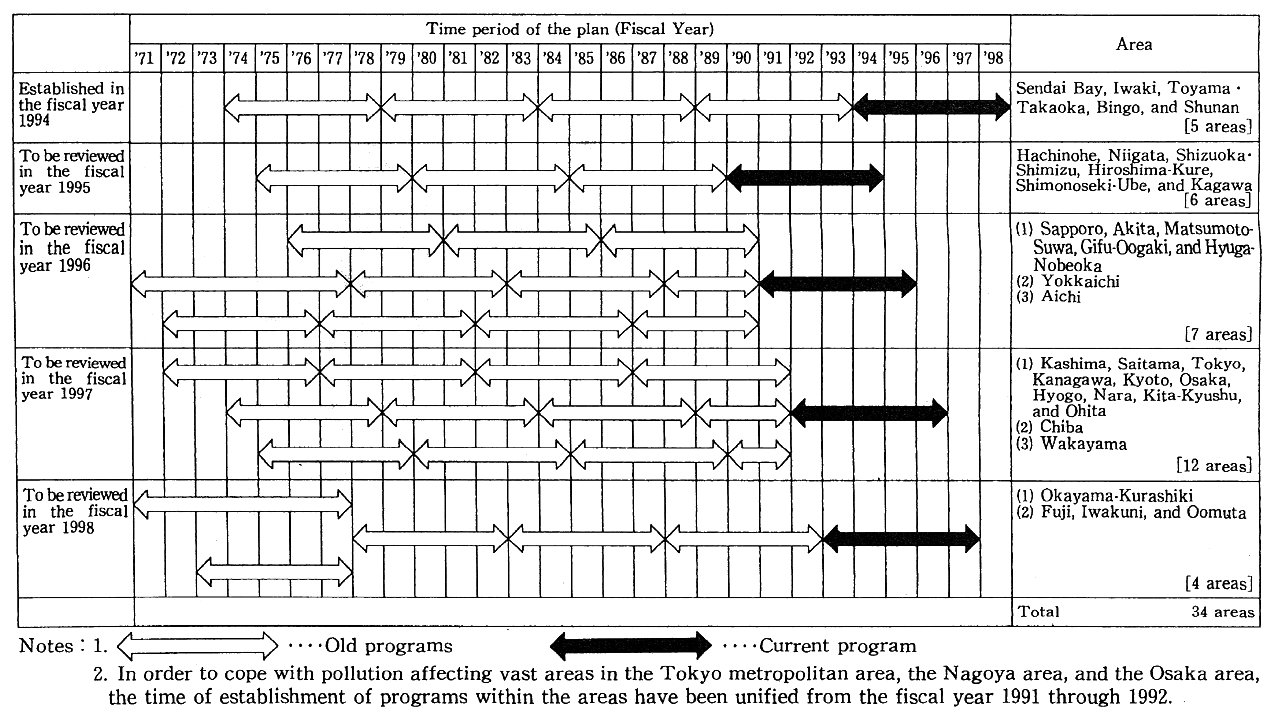
Fig. 6-5-1 Areas where Regional Environmental Pollution Control Programs have been established (Current plan)
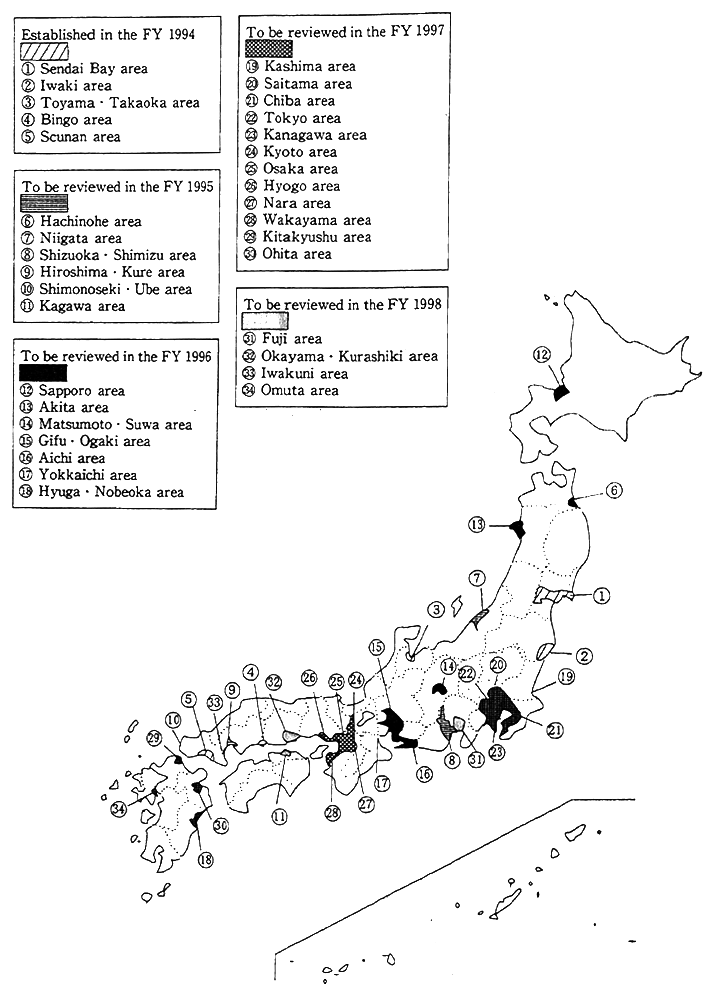
(2) Summary of the Regional Environmental Pollution Control Programs in the regions in which the programs were enforced in the fiscal year 1994
1) The boundaries of the regions
Table 6-5-2 indicates the boundaries of the regions in which the Regional Environmental Pollution Control Programs were enforced.
Table 6-5-2 Areas where Regional Environmental Pollution Control Programs Established and the Boundaries of the Areas
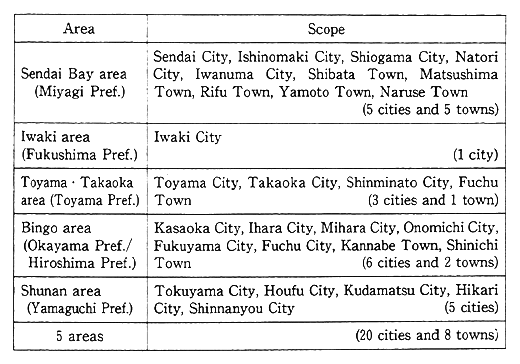
2) Objective of the programs
The objective of the programs is to meet the environmental quality standards set for air and water pollution, noise, soil pollution, and so forth. The programs should specify that the goals be attained within the time period of the application of the programs.
3) Time period for the application of the programs
The time period of the application of the programs is from the fiscal year of 1994 through 1998, a total of five years.
4) Measures to be taken to prevent pollution
Business owners are to take measures to prevent air pollution and water pollution, etc. Local governments are to enforce measures such as various regulations concerning the sources of pollution, the environmental impact assessment, guidance on locations of facilities, justification of land utilization, countermeasures for small businesses, and so on. Local governments are also expected to comprehensively promote the programs by carrying out pollution prevention projects as well as pollution related projects. The pollution prevention projects include: improvement of sewerage systems, buffer green zones, waste management facilities, and school environment; dredging and water conveyance; improving the quality of soil damaged by pollution; and strengthening of monitoring and measurement.systems. The pollution related projects include: improvement of parks and afforested areas countermeasures for transportation; and measures for ground subsi-dence.
5) Summary of expenses
The estimated amount of expenses required to enforce pollution preventive measures in the regions within the time period of the applica-tion of the programs is 79 billion yen for measures to be taken by businesses, 772.1 billion yen for projects in which countermeasures for pollution are taken, enforced by local governments, and 358.6 billion yen for pollution related projects that are also enforced by local govern-ments.
6) Promotion of enforcement of the pollution prevention programs
i. Enforcement of the Pollution prevention programs
Local governments are taking comprehensive measures to pre-vent pollution in accordance with the Regional Environmental Pollution Contral Programs. Table 6-5-3 shows the progress of projects. The total working expenses of the fiscal year 1994 for pollution preventive pro-jects is 3,387.9 billion yen, consisting of 2,425.2 billion yen for projects in which countermeasures for pollution are taken and 962.7 billion yen for projects that are related to pollution.
ii. Special financial measures taken for pollution preventive projects
In an effort to further promote measures for prevention of pollution, various special financial measures based on the Law on Special Financial Arrangement by the Government for Public Pollution Contral Projects (referred to as 'Pollution Control Financial Special Law' hereafter) were taken for pollution prevention projects. These measures were enforced by local governments in conformity with the Regional Environmental Pollution Control Programs. Those financial measures include increases in the amount of the Government's portion of the cost, in the amount of subsidies, expansion of types of ventures to which local bonds can be applied, inclusion of redemption money for the principal and interest of local bonds into the amount of basic fiscal demand, and so forth.
Table 6-5-4 shows the working expenses and increased amounts of the Government's subsidies for projects enforcing pollution preven-tive measures for the last five years. The total amount of increase in the Government's subsidies for the fiscal year of 1994 is 47.4 billion yen.
iii. State of major environmental quality in the regions in which Regional Environmental Pollution Control Programs are enforced
The following is the state of principal environmental quality in the regions in which various measures are enforced according to the Regional Environmental Pollution Control Programs.
As for sulfur dioxides, the ratio of monitoring stations recording levels that met the criteria per long-term evaluation of the environmen-tal quality standards (the number of monitoring stations recording levels that met the criteria divided by the number of valid monitoring stations) was 100% in the fiscal year 1993.
Table 6-5-5 shows the level of achievement of the environmental quality standards for nitrogen dioxides. In the fiscal year 1993, 7.7% of the monitoring stations measured the level of 0.06 ppm, which is the upper limit of the environmental quality standard.
Table 6-5-3 The Enforcement Status of Projects Stipulated in Regional Environmental Pollution Control Programs
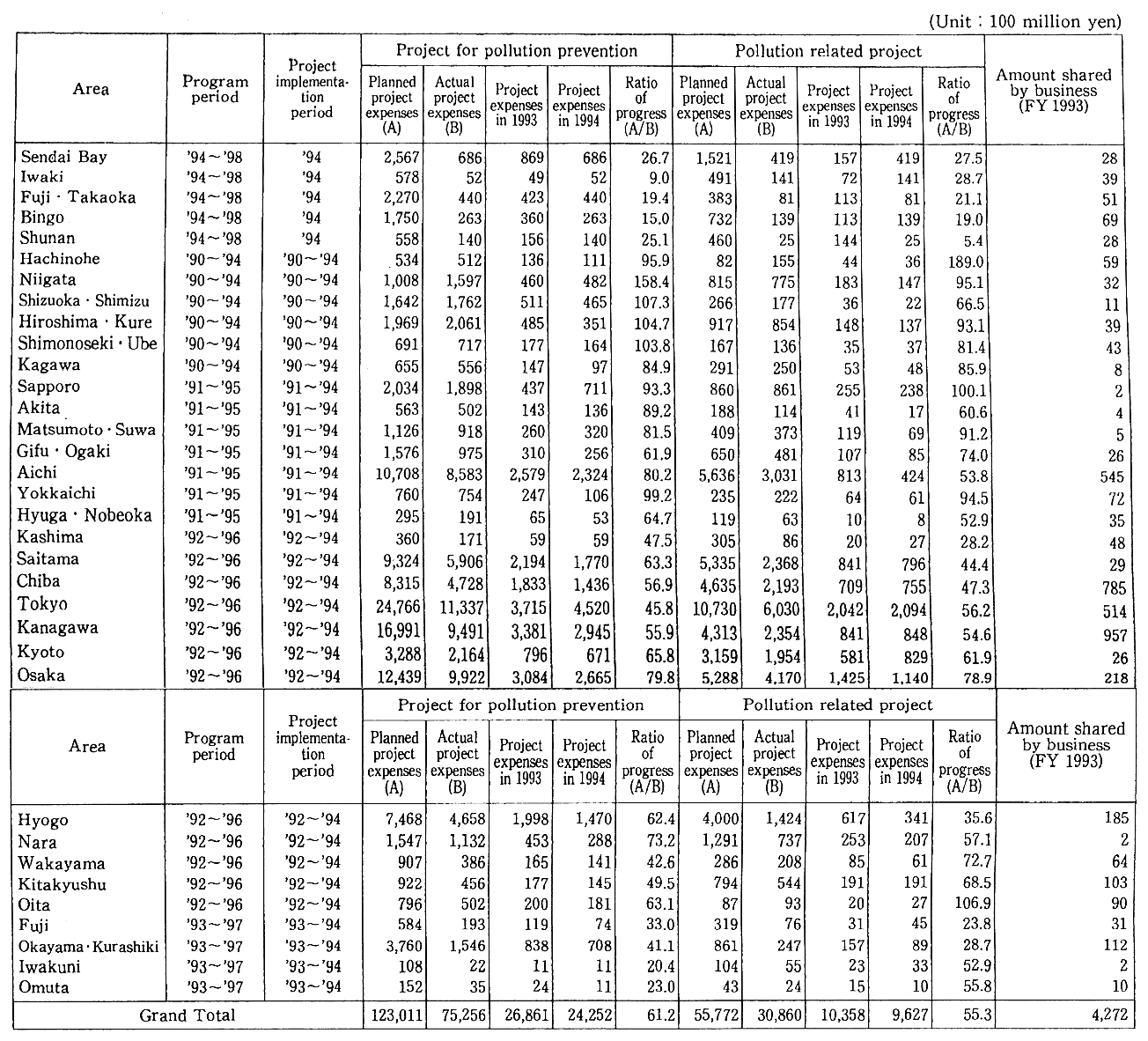
Notes:1. Data by Environment Agency.
2. Projects for pollution prevention are projects that are carried out in order to prevent pollution such as development of sewerage systems; development of buffer green zones development of waste disposal facilities ;improvement of school environment ; dredging and water induction; land improvement to control pollution ; improvement of monitoring systems, and so on.
3. Pollution related projects are projects that are related to prevention of pollution such as development of parks, green zones measures against traffic ; measures against ground subsidence, and so on.
4. The project expenses in 1993 are the amount confirmed, the project expenses in 1994 are the amount estimated. The project expenses in 1994 for areas in which the plan has been established in 1994 are the project expenses indicated in the previous program which had been completed.
5. Sub-totals of each area and the grand total do not agree since figures have been rounded.
Table 6-5-4 Project Expenses and Amounts of Increase in Government's Share or Subsidy concerning Public Pollution Control Projects
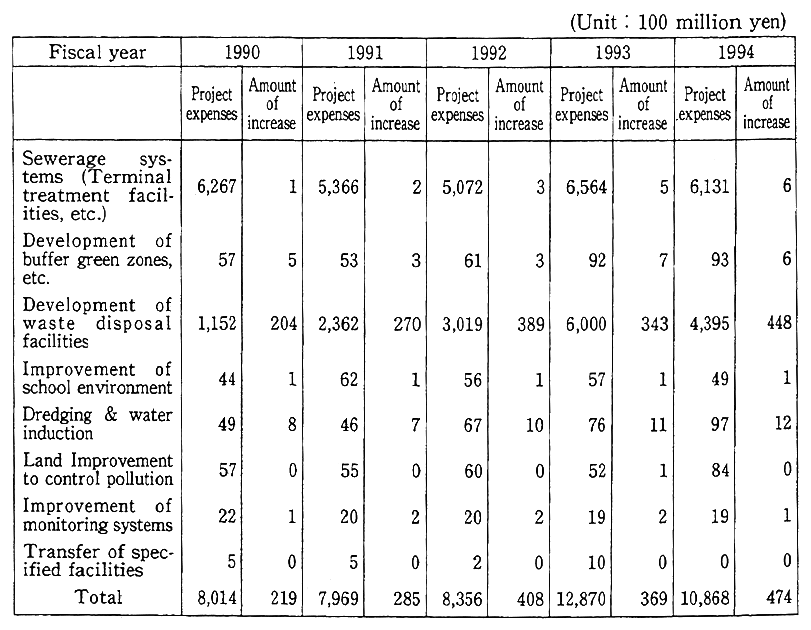
Notes:1. Data by Environment Agency
2. Project expenses and amount of increase in the fiscal year 1994 are estimated amounts.
Table 6-5-5 Achievement Status of the Enviroumental Quality Standards concerning Nitrogen Dioxide in the Areas where Regional Environmental Pollution Conrol Programs are Enforced
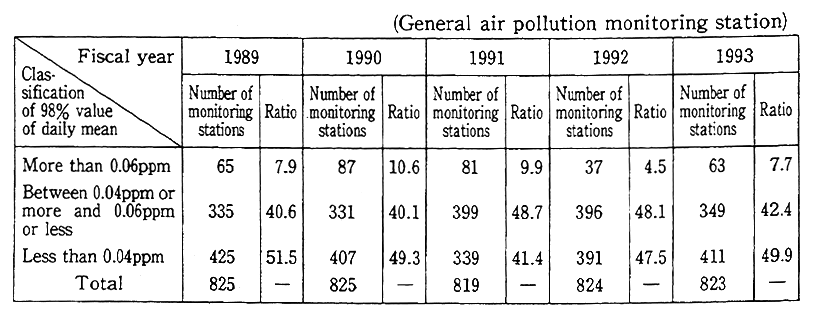
Notes: 1. Data by Environment Agency
2. Monitoring stations which have not completed the valid monitoring hours are excluded.
3. Zaruzman's coefficient =0.84
Table 6-5-6 shows the level of achievement per the long-term evaluation of the environmental quality standards for suspended partic ulate matter. The level of achievement in the fiscal year 1993 was 44.1%.
As for the level of photochemical oxidants, seven monitoring stations out of 691 stations recorded levels satisfying those set by the environmental quality standard (less than 0.06 ppm per hour) in the fiscal year of 1993. There are 306 stations recorded levels of photochem ical oxidants exceeding the level that requires issuance of a warning (0.12 ppm per hour).
Table 6-5-7 shows the achievement level of environmental criteria for water quality of rivers, lakes and reservoirs, and sea areas per BOD or COD (number of areas satisfying criteria divided by number of all areas measured). The achievement rates for rivers (BOD), lakes and reservoirs (COD), and sea areas (COD) of the fiscal year 1993 are 66.7%, 21.7%, and 72.4% respectively.
iv. Implementation of pollution preventive projects designated by the Minister of Home Affairs
For those pollution preventive projects that are conducted by local governments in areas outside the regions in which Regional Environmental Pollution Control Programs are enforced, and are designated by the Minister of Home Affairs upon deliberation with the minister in charge and the Director-General of the Environment Agency, the same special financial measures as those that were applied to pollution preventive projects based on the Programs were taken, pursu-ant to Section 3, Article 3 of the Pollution Control Financial Special Law.
Section6. Promotion of Environmental Conservation Measures for High-Technologies
In company with the recent remarkable advances in areas such as microelectronics, new materials, biotechnologies, the so-called high-technologies, the industrial structure in Japan has been changing.
It has been pointed out that there are possible environmental hazards that are caused by the development and use of these technol-ogies, and that they are different from any existing problems in respect to their sources, emission forms and in their various impacts.
Table 6-5-6 Achievement Status of the Environmental Quality Standards concerning Suspended Particulate Matter in the Areas where Regional Environmental Pollu- tion Control Programs are Enforced

Notes: 1. Data by Environment Agency
2. Monitoring stations which have not completed the valid monitoring hours
are excluded.
Table 6-5-7 Achievement Status of the Euvironmental Quality Standards in Rivers, Lakes and Reservoirs and Sea Areas in the Areas where Regional Environmental Pollution Control Programs are Enforced
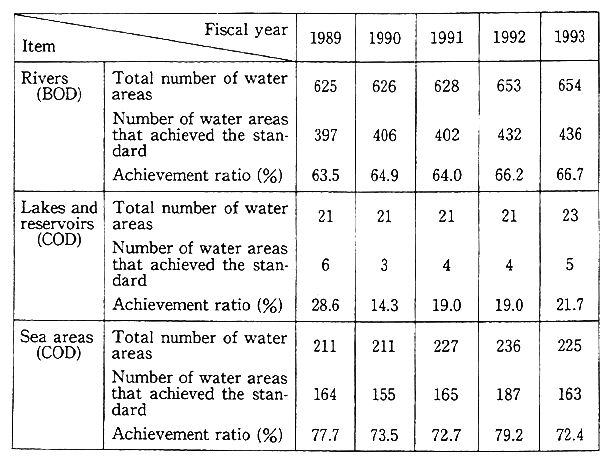
With these changes of circumstance in mind, a thorough study on the possible impact on the environment must be conducted prior to use of such high-technologies so that no environmental problems will be created in the future. On the other hand, it is also important to actively promote the application of such high-technologies in the field of environ-mental conservation.
The Environment Agency put together the Report of the Environ-mental Technology Council in April 1987, to specify the basic direction in the field of environmental conservation, corresponding to the prog-ress of high-technologies. Among those technologies, the Environment Agency especially focuses on the area related to ICs which has the potential to significantly impact the environment, and published related technical materials and conducted the Fact Finding Survey on the IC Industry in fiscal year 1986 jointly with the Ministry of Health and Welfare, Ministry of International Trade and Industry, and the Ministry of Labor. As for the area of new materials, the Agency collected and improved related technical information, and published the Guidebook related to Environmental Protection for Engineering Plastics in Decem-ber 1989.
As for recombinant DNA technologies, guidelines for safety in the experimental stages and in industrial application stages have been published by the ministries and agencies concerned. Currently, uses of recombinant DNA organisms are being practiced in closed systems and open systems. As for the release of recombinant DNA plants into the environment, ten cases of field trials have been conducted in Japan, and more than 2,100 cases have been conducted worldwide as of the end of the fiscal year 1994. In the United States, marketing of recombinant DNA plants (tomatoes) has begun in May 1994. In Japan, confirmation of safety assessment of. environmental impact by field trials were conducted concerning recombinant DNA plants such as tomatoes, rice plants, and petunias, in accordance with the Guideline for Recombinant DNA Experiments established by the Science and Technology Agency, and with the guidelines of the Ministry of Agriculture, Forestry, and Fisheries. Since the results of these investigations have proven that the open-system application programs meet the requirements set by the guidelines, cultivation of these plants in general fields has begun as of 1992. As for recombinant DNA animals, operation of the Guideline for Recombinant DNA Experiments was revised in August 1994, and a concept about experiments using animals in the non-closed and isolated system was presented. Currently, experiments have been conducted in conformity with this concept.
No environmental problems caused by development or use of modern biotechnologies, such as recombination DNA technologies, have been reported as of today.
In December 1991, the Expert Committee on Biotechnology, which was established within the Planning Committee of the Central Council for Environmental Pollution Control to deliberate on biotech-nologies and environmental conservation issues, put together a report and presented it to the Planning Committee. The report pointed out that environmental impact assessment should be conducted for individual programs in relation to the environmental release of genetically modified organisms. According to the report, the Environment Agency reviewed technical matters for the environmental impact assessment of these technologies, and is to continue to investigate on specific adminis-trative measures while giving consideration to the progress of scientific knowledge.
The Environment Agency has started an investigation on the promotion of sound utilization of an environmental restoration technol-ogy called bioremediation, a technology to purify soil or underground water contaminated by toxic substances such as trichloroethylene, by means of microorganisms.
As a part of activities to promote application of biotechnologies for the field of environmental conservation, the National Institute for Environmental Studies has conducted studies on application of biotech-nologies for environmental conservation and their environmental impact. The institute has been accommodating the storage in its Facil-ity for Microbial Culture Collection of genes of microorganisms which are essential for environmental conservation studies due to their effect on environmental pollution as well as purification. To further enhance their capability of studying the usage and impact of recombinant DNA organisms, the institute added a Biotechnology Laboratory to its exist-ing facilities in October 1993. The Ministry of International Trade and Industry and the Ministry of Agriculture, Forestry, and Fisheries have started studies on application of biotechnology, in the field of environ-mental benign production, such as environmental conservative technol-ogies for production of hydrogen.
Section7. Safety Measures for Chemical Substances
1. Promoting Safety Related Policies for Chemical Substances
(1) In October 1973, the Law concerning the Examination and Regu-lation of Manufacture, Etc., of Chemical Substances (referred to as "the Chemical Substances Control Law" hereafter) was enforced. This law specifies that all newly-introduced chemical substances be examined for their degradability, accumulability, and chronic toxicity prior to their production or importation (examination of newly introduced chemical substances prior to their production or importation). Chemical sub-stances that have all of the said properties were designated as Specified Chemical Substances, and their production, importation, and use have been controlled. According the amendments of this law enforced in May 1986, the chemical substances that were designated as Specified Chemi-cal Substances by the old law are currently designated as "Class I Specified Chemical Substances." Chemical substances that do not have accumulability but are undegradable and have potential chronic toxicity are now designated as "Designated Chemical Substances," and their production amount has been monitored. If the said chemical substances are anticipated to create environmental pollution in a vast area, causing harm to human health, examinations of their toxicity are to be conduct-ed. In case the results of the examinations prove that the substances do have chronic toxicity, etc., they are to be designated as "Class II Specified Chemical Substances." The revised law specifies that techni-cal guidelines concerning handling of these substances be observed, and that warning labels pertaining to environmental pollution prevention be mandatory. The law also specifies that the amount of production or importation of these substances be regulated as necessary (Figure 6-7-1).
Notifications of newly-introduced chemical substances are to be submitted to the Minister of Health and Welfare or the Minister of International Trade and Industry. There were 227 notifications were submitted in the fiscal year 1994 ; 135 newly-introduced chemical sub-stances have been classified as Designated Chemical Substances as of the end of 1994. Safety of the existing chemical substances has been examined by the following ministries. The Ministry of International Trade and Industry conducts investigations on degradability and ac-cumulability of chemical substances and the Ministry of Health and Welfare conducts examinations of chronic toxicity while the Environ-ment Agency investigates existence of chemical substances in the environment. As of the end of 1994, nine substances have been classified as Class I Specified Chemical Substances, 23 substances as Class II Specified Chemical Substances, and 135 substances including chloro-form have been classified as Designated Chemical Substances.
Fig. 6-7-1 Regulations on Chemical Substances According to the Chemicalt Substances Control Law
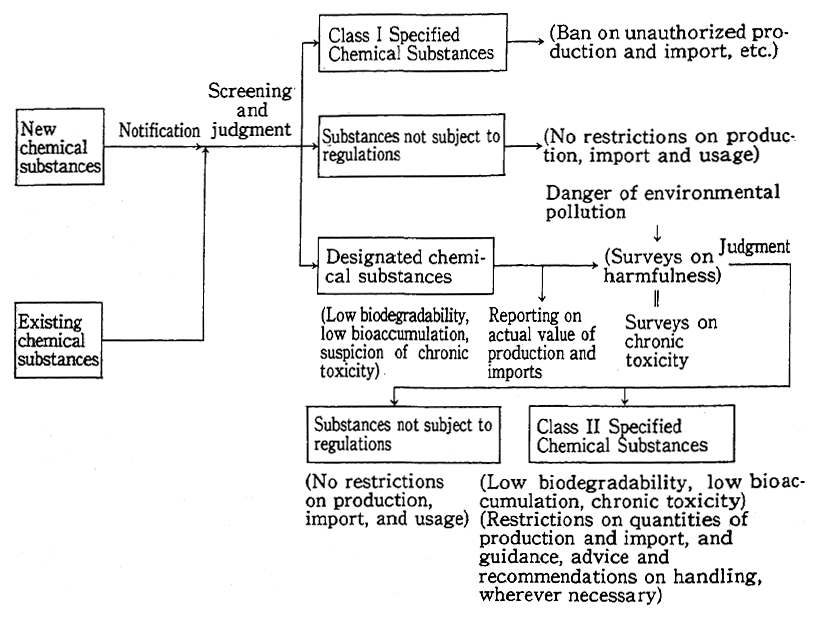
(2) To inspect the safety of the existing chemical substances, the Ministry of International Trade and Industry conducts experiments to see degradability and accumulability of substances. As of the end of 1994, 1,018 substances have been examined for their safety. The ministry has also been promoting development projects of new test methods in order to allow examinations of the existing chemical substances to be as quick and accurate as possible.
The Ministry of Health and Welfare has been engaged in research and development of test methods for chronic toxicity and toxicity of the existing chemical substances. The ministry has also been working on development of domestic inspection support systems to strengthen safety inspections of the existing chemical substances.